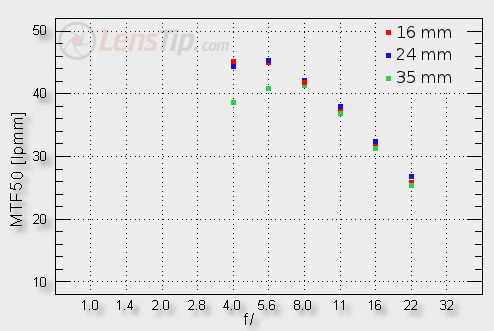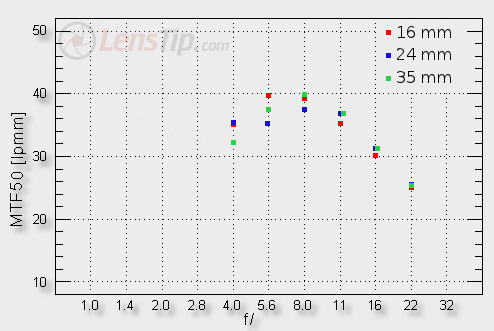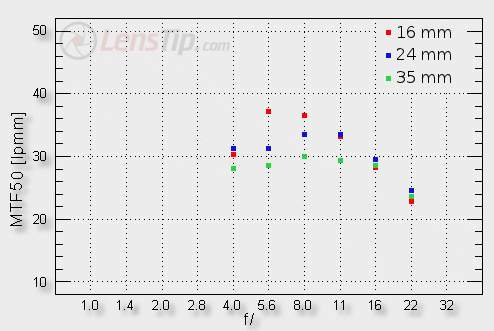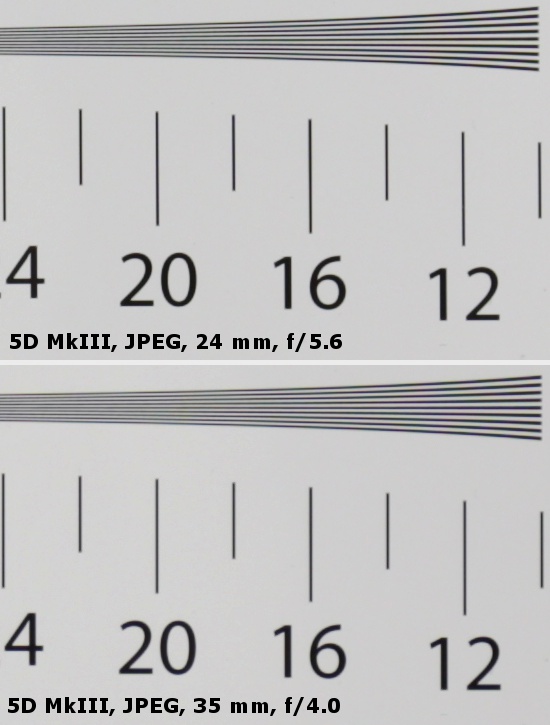Canon EF 16-35 mm f/4L IS USM
4. Image resolution
Let’s check how the tested Canon fares in the frame centre. Its results at 16, 24 and 35 mm focal lengths are presented on the graph below.

Please Support UsIf you enjoy our reviews and articles, and you want us to continue our work please, support our website by donating through PayPal. The funds are going to be used for paying our editorial team, renting servers, and equipping our testing studio; only that way we will be able to continue providing you interesting content for free. |
- - - - - - - - - - - - - - - - - - - - - - - - - - - - - - - - - - - - - - - - - - - - - - - -
The values you get at 16 and 24 mm can be called sensational for a zoom lens. Already at the maximum relative aperture and also by f/5.6 the lens reaches an excellent level of 45-46 lpmm. You don’t have to stop it down at all in order to enjoy an outstandingly sharp image.
The maximum focal length fares a bit worse but even there it would be difficult to complain, At the maximum relative aperture you see MTFs as high as over 38 lpmm and on slight stopping down the lens is able to exceed a level of 40 lpmm. Only the worst grumblers would find something wrong with that.
Still the performance on the edge of the frame is a real challenge for an ultra-wide angle lens. First let’s check the performance on the edge of the APS-C sensor.

In a nutshell – the situation is good. The maximum relative aperture is useful at every focal range and on stopping down the lens to near f/5.6-8.0 you get to a very high MTF level of 40 lpmm.
Of course the edge of full frame is the most demanding test, a place where many other ultra-wide angle lenses, produced by Canon, failed; we were even more curious how the newest construction would fare.

Definitely you shouldn’t talk about any failure here, quite the opposite. Taking into account the difficulty of the task you can even say the results are positively decent. The 16 mm focal length fares very well – it should be satisfactory for fans of landscape photography. On slight stopping down you can enjoy a very sharp image across the frame and an angle of view as wide as 107 degrees.
The worst results we registered at 35 mm; as a consolation we can add that the lens was only a tad below the decency level and, at that focal length, you will rarely need all the frame to be outstandingly sharp so a bit worse performance in the corners of full frame is likely to get lost among blur caused by the shallower depth of field.
To sum up there’s no doubt that the Canon EF 16–35 mm f/4L IS USM is the best ultra-wide angle lens produced by the Canon company so far. What’s more, at every focal length it fares better than its direct rival, the Nikkor AF-S 16-35 mm f/4G ED VR. The Canon constructors did an excellent job. One might also add – finally.
At the end we present crops taken from photos of our resolution testing chart; the photos were saved as JPEG files along with RAW files, used for the analysis above.
 |






